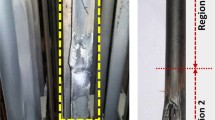Abstract
The failure of a high-pressure fire-extinguishing cylinder was investigated. Failure was induced by internal surface corrosion and stress corrosion cracking (SCC) due to condensation of carbonic acid. In internal surface, especially the area near the bottom of the exploded cylinder, severe corrosion was characterized by local pits. SCC initiated from these local corrosion pits was observed by metallurgical analysis. Microstructure of the failure cylinder near the internal surface consisted of multiple-banded structure and the banded structure could accelerate local corrosion initiation and propagation. The corrosion products built up on the fracture surface were primarily ferrous carbonate (FeCO3). The determination of moisture in fire-extinguishing gas was also examined.




Similar content being viewed by others
References
E.D.D. During, Corrosion Atlas: A Collection of Illustrated Case Histories. Case History 01.02.01.01 and 01.02.02.01, vol. 1 (Elsevier, Amsterdam, 1988)
G. Patane, E. Proverbio, A. Risitano, Corrosion induced failure of an air cylinder. J. Eng. Fail. Anal. 9(4), 481 (2002)
S. Nesic, M. Nordsveen, R. Nyborg, A Stangeland, A mechanistic model for CO2 corrosion with protective iron carbonate films, Corrosion/2001, NACE Paper No. 40, NACE International, Houston, 2001
S. Nesic, J. Postlethwaite, S. Olsen, An electrochemical model for prediction of corrosion of mild steel in aqueous carbon dioxide solutions. Corrosion 52, 280 (1996)
M.B. Kermani, A. Morshed, Carbon dioxide corrosion in oil and gas production: a compendium. Corrosion 59(8), 559 (2003)
S.D. Zhu, A.Q. Fu, J. Miao, Z.F. Yin, G.S. Zhou, J.F. Wei, Corrosion of N80 carbon steel in oil field formation water containing CO2 in the absence and presence of acetic acid. Corros. Sci. 53, 3156 (2011)
D. Haedie, S.E. Liu, The effect of stress concentration on hydrogen embrittlement of a low alloy steel. Corros. Sci. 38(4), 721 (1996)
Q. Zhou, X.S. Fu, S.J. Huang, Influence of banded structure in special oil tube on CO2 corrosion behavior at low temperatures. Corros. Prot. 26(11), 472 (2005)
Author information
Authors and Affiliations
Corresponding author
Rights and permissions
About this article
Cite this article
Jiang, Y., Gong, Jm. & Tang, Pj. Corrosion Induced Explosion of a High-Pressure Fire-Extinguishing Gas Cylinder. J Fail. Anal. and Preven. 14, 564–568 (2014). https://doi.org/10.1007/s11668-014-9851-1
Received:
Revised:
Published:
Issue Date:
DOI: https://doi.org/10.1007/s11668-014-9851-1




